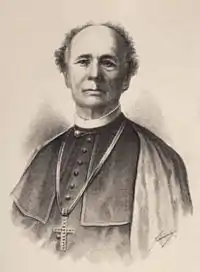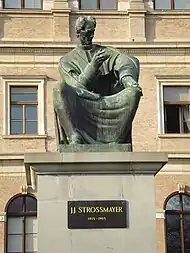Josip Juraj Strossmayer | |
|---|---|
 Josip Juraj Strossmayer by Josip Franjo Mücke | |
| Born | 4 February 1815 |
| Died | 8 April 1905 (aged 90) |
| Resting place | Đakovo Cathedral, Đakovo, Croatia 45°18′27.9″N 18°24′39″E / 45.307750°N 18.41083°E |
| Other names | Joseph Georg Strossmayer |
| Alma mater | University of Vienna |
| Occupation(s) | Bishop, politician, professor |
| Years active | 1838–1905 |
| Known for | Founder of Yugoslav Academy of Sciences and Arts |
| Political party | People's Party (until 1880) Independent People's Party (1880–1905) |
| Movement | Illyrian Movement |
| Signature | |
Josip Juraj Strossmayer, also Štrosmajer (pronounced [jǒsip jûraj ʃtrǒsmajer]; German: Joseph Georg Strossmayer;[1] 4 February 1815 – 8 April 1905) was a Croatian politician, Roman Catholic bishop, and benefactor.[2]
Early life and rise as a cleric
.jpg.webp)
Strossmayer was born in Osijek to a Croatian family. His great-grandfather was an ethnic German immigrant from Styria who had married a Croatian woman. He finished school at a gymnasium in Osijek, and then graduated theology at the Catholic seminary in Đakovo. He earned a PhD in philosophy at a high seminary in Budapest, at the age of 20.[2]
In 1838, he worked as a vicar in Petrovaradin, before moving to Vienna in 1840 to the Augustineum and the University of Vienna, where he received another doctorate in philosophy and Canon law in 1842. In 1847, he was made the Habsburg palace chaplain (a position he would hold until 1859), and named one of the rectors of the Augustineum.[2]
Cultural policy
Strossmayer was instrumental in the founding of the Yugoslav Academy of Sciences and Arts in 1866, as well as the re-establishment of the University of Zagreb in 1874.[3][4] He initiated the building of the Academy Palace (completed in 1880) and set up The Strossmayer Gallery of Old Masters (1884) in Zagreb.[5]
Strossmayer aided the creation of the printing house in Cetinje, helped found the Matica slovenska and actively supported Matica srpska, the national culture societies of the Slovenes and the Serbs, respectively.

Catholic diplomacy
At the Vatican Council he was one of the most notable opponents of papal infallibility, and distinguished himself as a speaker. The pope praised Strossmayer's "remarkably good Latin." A speech in which he defended Protestantism made a great sensation.[2] Another speech, delivered on 2 June 1870 is attributed to him.[6] The speech was forged by a former Augustinian, a Mexican named José Agustín de Escudero. It is full of heresies and denies not only infallibility but also the primacy of the pope.[2] On 26 December 1872, he published the decrees of the council in his official paper.[2] He later proclaimed his submission to the pope, as in his pastoral letter of 28 February 1881, on Sts. Cyril and Methodius, expressing his devotion to the papal see at times in extravagant language.[7]
Personal life

Since the early days of his episcopate, he was a close friend of Franjo Rački, the most renowned Croatian historian of his time. When the Academy was founded in 1867, Strossmayer was named chief sponsor, and Rački its President. In 1894, when Rački died, Strossmayer wrote: "I lost my dearest friend... I lost a part of myself... the good half of everything I have created was his thought, his credit and his glory". Their friendship was well documented in a series of four books containing their letters, compiled by historian Ferdo Šišić.[8]
Legacy

Bishop Nikolaj Velimirović dedicated a booklet entitled Religion and Nationality in Serbia to Strossmayer: “to the memory of the great Croatian patriot Bishop Strossmayer on the centenary of his birth (1815–1915)".[9]
In 1881, Schulzer (a Hungarian-Croatian army officer and mycologist) published a genus of fungi in the family Helotiaceae as Strossmayeria which was named in Strossmayer's honour.[10][11]
References
- ↑ Arthur J. May, The Hapsburg Monarchy, 1867–1914 (New York: W. W. Norton, 1968), 73. Contemporaries spelled the name "Straussmeyer".
- 1 2 3 4 5 6 Klemens Löffler (1912). "Catholic Encyclopedia: Joseph Georg Strossmayer". The Catholic Encyclopedia Vol. 14. Robert Appleton Company, New York. Retrieved 2010-04-18.
- ↑ "History of the University of Zagreb". University of Zagreb. 2005. Retrieved 2010-09-30.
Bishop Josip Juraj Strossmayer in 1861 proposed to the Croatian Parliament that a legal basis be established for the founding of the University of Zagreb. During his visit to Zagreb in 1869 the Emperor Franz Joseph signed the Decree on the Establishment of the University of Zagreb.
- ↑ Josip Juraj Strossmayer (1861-04-29). "Akademija znanosti - put prema narodnom obrazovanju". Speech in the Croatian Parliament (in Croatian). Wikisource. Retrieved 2010-09-30.
- ↑ "Croatian Academy of Sciences and Arts - The Founding of the Academy". Croatian Academy of Sciences and Arts. 2007. Archived from the original on 2010-06-06. Retrieved 2010-04-18.
- ↑ East European Accessions Index, Volume 4. U.S. Government Printing Office. 1955. p. 58.
- ↑ Standish, Russell R.; Standish, Colin D. (2001). Two Beasts, Three Deadly Wounds, and Fourteen Popes. Hartland Publications. p. 173. ISBN 978-0-92330-974-9.
- ↑ Polić, Maja (2011). "Nekadašnja Rijeka i Riječani, s osvrtom na korespondenciju Rački – Strossmayer". Problemi Sjevernog Jadrana (in Croatian) (11): 39–71. Retrieved 20 April 2013.
- ↑ Markovich, Slobodan G. (2017). "Activities of Father Nikolai Velimirovich in Great Britain during the Great War". Balcanica. 48: 152.
- ↑ Burkhardt, Lotte (2022). Eine Enzyklopädie zu eponymischen Pflanzennamen [Encyclopedia of eponymic plant names] (pdf) (in German). Berlin: Botanic Garden and Botanical Museum, Freie Universität Berlin. doi:10.3372/epolist2022. ISBN 978-3-946292-41-8. Retrieved January 27, 2022.
- ↑ "Strossmayeria - Search Page". www.speciesfungorum.org. Species Fungorum. Retrieved 9 November 2022.
Further reading
- Jelčić, Dubravko (2005). "Ljetopis Josipa Jurja Strossmayera" (PDF). Izabrani književni i politički spisi I. Stoljeća hrvatske književnosti (in Croatian). Zagreb: Matica hrvatska. pp. 53–55. ISBN 953-150-285-4. Retrieved 13 June 2020.
- "Bishop Strossmayer's Speech in the Vatican Council of 1870". Plymouth Brethren Archive. Retrieved 2020-06-29. Speech attributed to Strossmayer. Its authenticity is disputed.